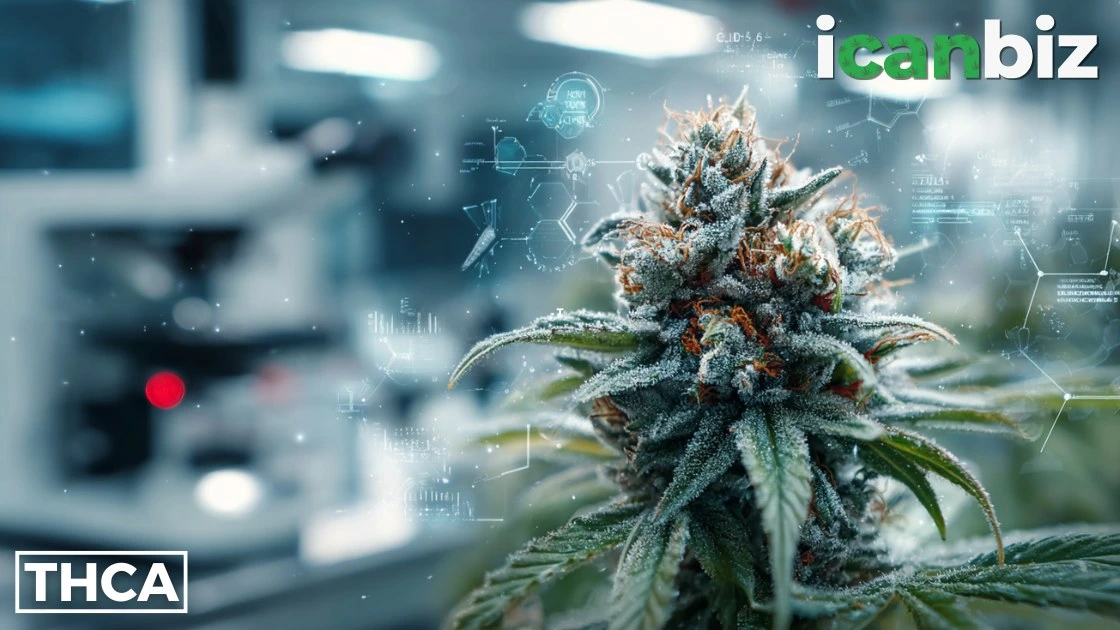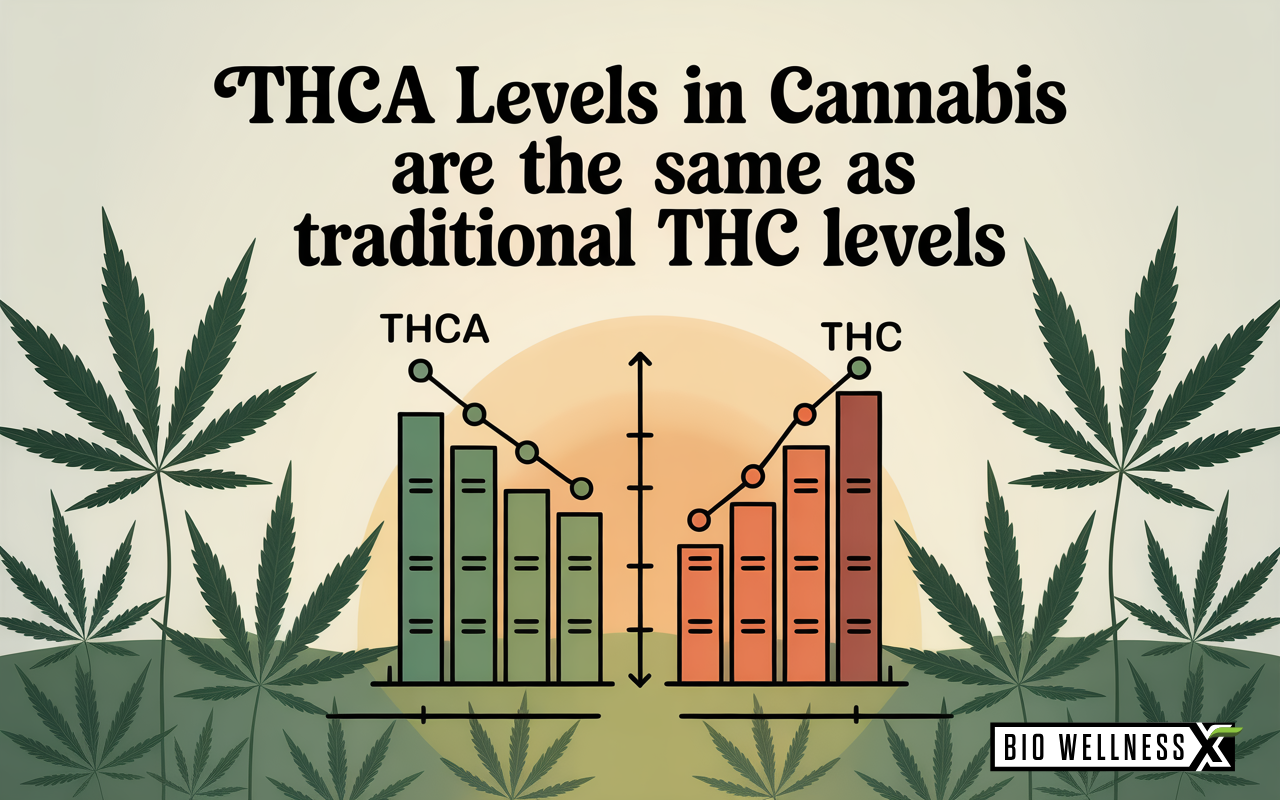
THCA is a non-psychoactive cannabinoid found in raw cannabis that only becomes intoxicating when exposed to heat through smoking, vaping, or cooking. That heating leads to decarboxylation, which transforms THCA into THC, unlocking its psychoactive potential, meaning raw cannabis won't get you high, but heated THCA flower definitely will. THCA potency is influenced by strain, plant age, harvest method, and how it’s consumed, especially when comparing flower, concentrates, and raw formats. Even if it's not heated, however, raw THCA may offer wellness benefits like reduced inflammation or nausea, appealing to users who want cannabis effects without the traditional high.
If you’ve ever found yourself wandering the world of cannabis products and wondered what all the buzz around THCA is about, you’re not alone. THCA (tetrahydrocannabinolic acid) might not be as instantly recognizable as THC or CBD, but it’s a major player when it comes to understanding cannabis potency—and it’s starting to get the spotlight it deserves. For those seeking high potency THC effects, understanding THCA potency is crucial, as it directly influences the intensity and duration of the high experienced from cannabis products.
Let’s get into it.
What Is THCA? The Cannabinoid You’re Just Starting to Hear About
THCA stands for tetrahydrocannabinolic acid. It’s a naturally occurring cannabinoid found in raw cannabis plants—especially in fresh cannabis plants, fresh cannabis plants especially, and young cannabis plants, which tend to have higher THCA content. THCA is a naturally occurring cannabinoid in raw cannabis and is the primary occurring cannabinoid in raw cannabis plant material. You’ll often find high levels of THCA present in premium flower that hasn’t been decarboxylated (i.e., exposed to heat).
Here’s where it gets interesting: THCA in its raw form doesn’t produce psychoactive effects unless it’s heated. That means eating a raw cannabis plant or raw bud isn’t going to get you high—but heat changes the game completely.
When THCA flower is smoked, vaped or cooked, that basic THCA converts into THC, the well-known psychoactive compound in cannabis, when it’s exposed to heat through smoking, vaping, or baking. This chemical change, known as decarboxylation, is how THC unleashes its psychoactive potential. That’s the magic behind most cannabis experiences.
Understanding THCA Potency: What Influences Strength?

Now for the big question: how strong is THCA?
It depends on a few factors:
- Cannabis strain: Some plants naturally produce higher THCA levels.
- Harvesting time: Younger plants often have more THCA.
- Product type: THCA flower vs concentrates vs raw extracts will vary widely in potency.
- Consumption method: As we mentioned earlier, the way you consume THCA changes the potency you feel. The form THCA doesn’t produce a high unless heat is applied, because THCA converting through decarboxylation is what activates its psychoactive effects.
In terms of traditional weed, THCA percentage is pretty much the same strength as THC percentage. Because when THCA is exposed to heat, it undergoes decarboxylation, resulting in decarboxylated THCA, which is much more potent and psychoactive than its raw form.
So when you see a cannabis flower that’s 27% THC and a hemp flower that’s 27% THCA, that flower is going to have virtually identical effects when smoked. Hopefully that clears some things up for you!
How to Consume THCA: Consuming Raw THCA and More Ways to Enjoy It
If you’re wondering how to actually consume THCA, there are several options, each with different effects:
- Raw consumption: You can juice raw cannabis leaves or sprinkle raw buds into smoothies to retain the non-psychoactive benefits, since consuming THCA in its natural form does not produce a high.
- Smoking: Methods that involve heating are probably the most common way to consume TCHA. When you smoke or vape THCA, the heat decarboxylates it, converting it into psychoactive THC. This means you’re consuming THC after the conversion.
- Vaping: Vaping THCA also uses controlled heat for efficient decarboxylation, resulting in immediate effects similar to smoking. It tends to be easier on the lungs, which may explain it’s growing popularity.
- Concentrates: THCA concentrates, such as THCA diamonds or crystalline extracts, are typically used for dabbing. Applying heat vaporizes the concentrate, quickly converting THCA to THC and delivering intense effects.
The method of consumption matters a lot. For example, vaporizing allows you to control temperature and potentially avoid converting all the THCA, depending on your goal. On the other hand, what happens when you smoke THCA flower is pretty straightforward: you’re instantly converting it into THC and feeling the effects of consuming THC.
Chemical Structure and How It Works
THCA has a unique chemical structure that differentiates it from THC—it contains an extra carboxyl group. Tetrahydrocannabinolic acid THCA adds this carboxyl group, which is responsible for its non-psychoactive nature in raw form until decarboxylation occurs.
This seemingly small difference is a big deal. That extra group prevents THCA from binding to CB1 receptors in the brain, which is why raw THCA doesn’t produce a high.
But once heat converts THCA during decarboxylation, that carboxyl group gets knocked off. Now you’ve got THC, which absolutely can bind to those receptors, leading to the effects most cannabis consumers are familiar with.
You’ll find THCA present in greater amounts in young or freshly harvested cannabis plants. That’s why “live” products like THCA flower, raw extracts, and fresh juices can be so potent in their raw therapeutic value.
As researchers continue to study THCA and its potency, they’re finding that its benefits could be more far-reaching than previously thought—even without the high.
THCA vs THC: What’s the Difference?
THCA and THC are often used interchangeably in casual conversation, but they’re actually quite different. THCA is non-psychoactive, while THC is psychoactive. THCA doesn’t produce psychoactive effects in its raw form. Think of THCA as the prequel to the blockbuster movie that is THC.
The conversion is key: THCA converts to THC through heat, whether you’re smoking THCA flower, baking edibles, or dabbing a concentrate. Heat causes THCA to convert into THC, which is responsible for the psychoactive effects. Without that conversion, THCA in its raw state won’t alter your mind— meaning it won’t produce a high unless it is heated.
Unlike THC, consuming raw THCA offers a potentially therapeutic experience without the high. For people who want to explore the benefits of cannabis without feeling “stoned,” THCA is incredibly appealing.
And yes, THCA turns into a powerful force when it meets heat—but in its raw form, it might help with things like achy joints, nausea, and more.
Potential Risks and Considerations of THCA
While THCA is gaining popularity for its potential wellness benefits, it’s important to approach this naturally occurring cannabinoid with a bit of caution and awareness. In its raw form, THCA doesn’t produce psychoactive effects, making it appealing for those who want to enjoy the benefits of cannabis without feeling high. However, things can change quickly if you apply heat—whether through smoking, vaping, or cooking—since this process converts THCA into THC, which can produce psychoactive effects.
The quality of the cannabis plant you choose plays a big role in your experience. Factors that influence THCA potency include the strain, how the plant was grown, and how it was harvested and stored. High-quality cannabis plants tend to have more consistent levels of THCA, which means you can better predict the effects—especially if you plan to convert THCA into THC.
It’s also worth noting that even though raw THCA won’t get you high, accidental exposure to heat (like using it in recipes) can trigger the conversion process. This means you could end up with psychoactive effects when you weren’t expecting them.
In summary, understanding the factors that influence THCA and its potency—such as the quality of the cannabis and how you plan to consume it—can help you avoid surprises and make the most of your cannabis experience. Always start slow, pay attention to how your product is handled, and remember that THCA’s effects can shift dramatically once it’s converted into THC.
The Final Hit: THCA Is More Than Just Pre-THC
So there you have it—THCA is much more than just a stepping stone to THC. It’s a complex cannabinoid with its own therapeutic potential, interesting chemical makeup, and a growing fan base among wellness seekers and cannabis connoisseurs alike. Interest in cannabis plants is gaining due to the discovery of new cannabinoids like THCA, which highlight the plant’s strength, potency, and unique conversion process when heated.
Whether you want the high or not, knowing how THCA converts to THC, what affects potency, and how best to consume it puts you in the driver’s seat. Plus, we’re just scratching the surface—more studies are underway, and new products are launching all the time.
So next time you see “high THCA” on a label, don’t just pass it by. Whether you’re looking for the benefits of cannabis plants—such as those provided by cannabinoids like THCA—without the high, or planning a potent experience, THCA could be exactly what you need.

Legal Disclaimer:
By reading this information presented, you agree to release the author of any liability that comes from using this data. This post contains no legal advice. Claims about cannabinoids have not yet been approved by the FDA.
References
- https://www.nasdaq.com/articles/cannabis-market-forecast-top-trends-cannabis-2025
- https://www.expressnews.com/business/article/thc-cannabis-texas-ban-dan-patrick-sid-miller-19962200.php
- https://nypost.com/2024/09/01/us-news/bargain-buzz-ny-pot-farm-moves-100000-economical-dime-bags-under-legalization
- https://thecannabisindustry.org
- https://www.cannabisbusinesstimes.com
frequently asked questions
What is THCA and how is it different from THC?
THCA is the acidic precursor to THC. It doesn’t produce psychoactive effects in raw form. When heated, it converts to THC, which binds to brain receptors and causes the familiar cannabis high.
Can you get high from eating raw THCA flower?
No. Raw THCA isn’t psychoactive and won’t produce a high unless it’s heated. Eating raw cannabis may offer therapeutic effects, but not the euphoric sensations associated with THC.
What’s the best way to consume THCA for psychoactive effects?
To feel the high, consume THCA through smoking, vaping, or dabbing. These methods apply heat, converting THCA into psychoactive THC via decarboxylation—delivering potent and fast-acting results.
Is THCA legal under federal law?
Yes, under the 2018 Farm Bill, THCA products derived from hemp (with ≤0.3% delta-9 THC by dry weight) are federally compliant—but local laws still vary.
Why do some cannabis products show high THCA instead of THC?
Because THCA converts into THC when heated, a high THCA percentage signals strong potential effects once consumed via heat, particularly in flower and concentrates.
